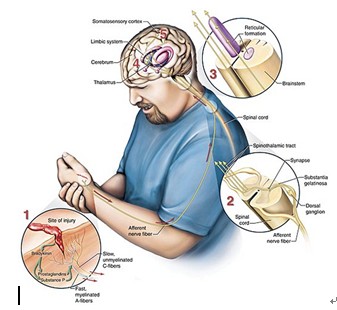

Complex Regional Pain Syndrome(CPRS)
Case Sharing
53-year-old Miss Fang works in the medical field. She often helps patients to get up, adjust and change their body to different positions. One day in October 2010, while working in the hospital, she had to help a patient to turn around and she strained the soft tissues of the hand due to excessive force. Later, she found that the lower arm began to have pain and redness, and the pain extended after two days. Ms. Fang’s arms and back of the shoulders cannot turn, and the hands are weak. In addition to the redness and swelling of the lower arms, her skin color has also changed, sometimes appearing purple, reddish brown or red.
When the hand is lightly pushed or touched, the hand hurts Ms. Fang took X-rays in the hospital and found no neck or hand fractures. Neither anti-inflammatory drugs nor painkillers could improve the pain.
After doing examinations and running tests on Miss Fang in November 2010, it was found that her neck and shoulder muscles were tight, and the pain extended to her hands when she touched her upper back and shoulders, and the skin of her lower arms was still red. The symptoms of this disease are very similar to those of complex regional pain syndrome, which can also be referred to as CRPS.
Cause
Complex Regional Pain Syndrome (CRPS)
Can be divided into two categories, CRPS type 1 and CRPS type 2. CRPS type I is secondary to injury, usually caused by soft tissue injuries. CRPS type II is a disease induced by certain nerve cord injuries. So far, no real cause of CRPS has been found, but some scholars have pointed out that it may be caused by the “neural mediators" in certain nerve tissues (chemical substances produced by nerve cells to transmit nerve impulses to other nerves during the injury process , muscles, organs or other tissues)” is overactive and affects the nerve transmission of blood vessels and skin and induces this particular pain.

Symptoms
The unique feature of CRPS is that when the patient only injures a small part of the body, such as fingers or toes, the entire upper or lower extremities will be involved, resulting in radiating pain. However, CRPS mostly occurs in the upper limbs, and the involvement of lower limbs is small.
CRPS Symtoms:
-Burning or burning pain in upper or lower extremities
-The skin of the upper or lower extremities is very sensitive, and it is painful to touch
-The skin temperature is abnormal, which can be hotter or colder than normal
- Change of skin color, brownish red, purple or red
-The texture of the skin is relatively smooth, thin and often sweats
-Swelling and pain in joints of upper or lower limbs
-Weak muscle strength and fatigue in the affected area
Diagnosis method
It is a little difficult to correctly diagnose CRPS, because there is no specific diagnosis or detection method, usually by observing the patient's symptoms and listening to the patient's medical history and ruling out other possible causes of this disease.
Treatment Method
Currently, there is no cure for CPRS. The treatment can only control the patient's pain and enhance the mobility of the affected area and surrounding joints, strengthening muscle training is also recommended so that the patient can return to daily activity as soon as possible.

 Book an Appointment
Book an Appointment


